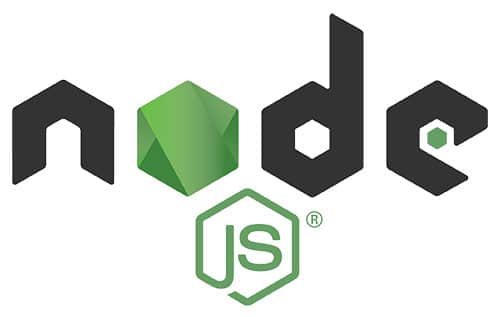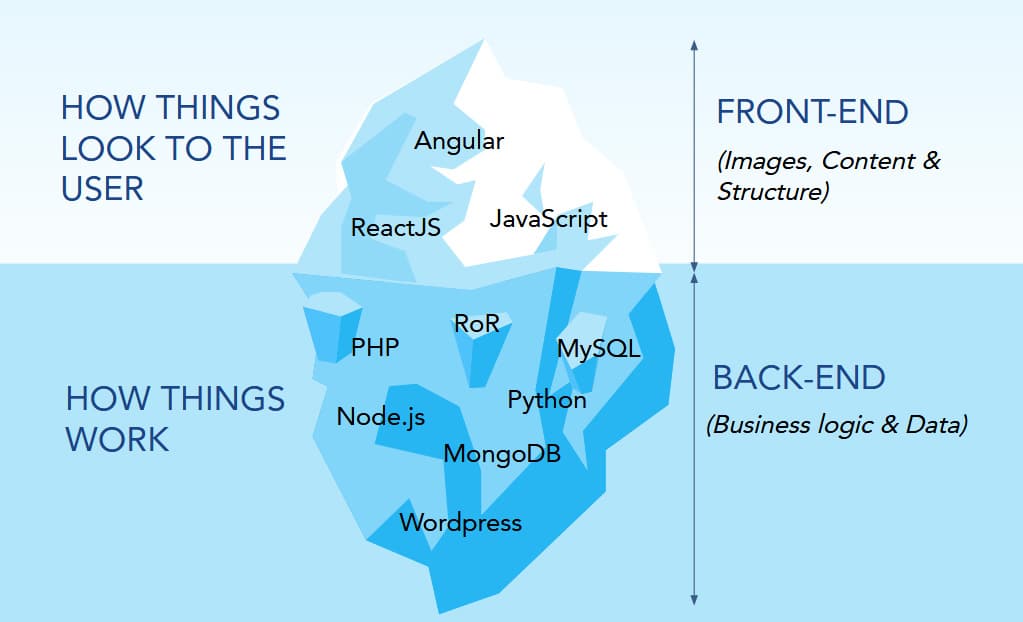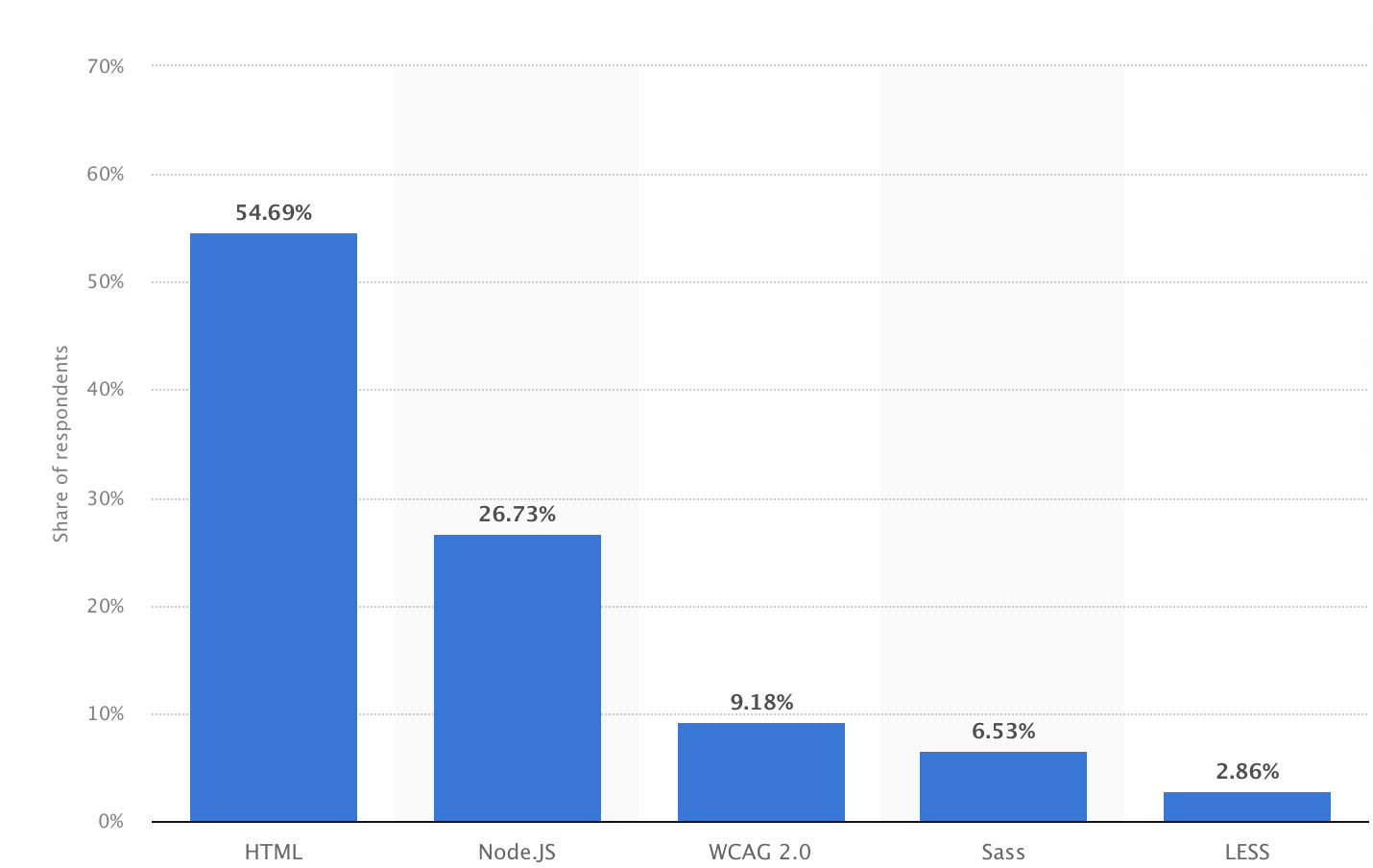Without further ado, let’s take a look at what makes Node.js tick and how well it compares to other tools and technologies in back-end programming.
In today's fast-paced digital era, companies leverage cutting-edge technology stacks to achieve significant cost savings and outperform their competitors. JavaScript is Central to the vibrant web development field, reigning supreme among programming languages. What's particularly noteworthy is JavaScript's flexibility, which, while commonly associated with client-side scripting, unleashes its full power in back-end operations through Node.js.
Node.js, an open-source application runtime environment, stands out for its efficiency and lightweight nature, especially compared to other server-side development frameworks. The rising popularity of Node.js for back-end development is evident as more firms offer specialized Node.js development services to create robust web applications. Prominent organizations such as NASA, Twitter, Uber, and PayPal have already integrated this technology into their operations, showcasing its versatility and strength.
This comprehensive article explores and clarifies the ongoing relevance and advantages of Node.js as a back-end tool. We will compare Node.js with alternative technologies and uncover its significant potential for contemporary businesses. Keep reading to discover the myriad ways Node.js can be a game-changer for your company's back-end needs.
What Is Node.Js and How It Works?

Node.js, written in JavaScript, stands as a transformative framework in the world of web development. Its primary function is to facilitate back-end operations, efficiently covering aspects traditionally managed by server-side languages like PHP, Java, Ruby, and Python. By seamlessly blending front-end and back-end development techniques, Node.js operates within its own runtime environment on the server, setting a new standard for back-end development.
When considering how Node.js functions in real-world scenarios, its impact is notably evident in how companies like Netflix leverage its capabilities. As an event-driven and single-threaded framework, Node.js is pivotal in supporting sophisticated web-based services such as content streaming. The adoption of this JavaScript-based tool has enabled Netflix to substantially decrease startup times and efficiently integrate microservices into its existing framework, demonstrating the effectiveness of Node.js in back-end web application development.
Intro to internal mechanics of Node.js
Exploring the internal mechanics of Node.js reveals why it stands out from traditional technologies like PHP. As an event loop framework, Node.js excels in handling multiple concurrent requests on a single thread, avoiding the common pitfalls of blocking operations. This approach ensures that Node.js is both efficient and scalable for back-end development.
The framework's prowess is further amplified by its non-blocking I/O model and the inclusion of npm, a versatile package manager. These features make Node.js exceptionally well-suited for developing new web projects or enhancing existing ones, solidifying its role as a cornerstone technology in modern back-end development.
Moreover, is Node.js back-end development superior to other technologies? To answer this, one must consider Node.js's unique ability to handle high volumes of asynchronous I/O operations, a critical requirement in today's data-driven web applications. This efficiency, coupled with the extensive library support provided by npm, positions Node.js as a highly effective tool for back-end development, capable of delivering high-performance web services with relative ease.
Thus, Node.js represents a significant shift in how back-end web development is approached. Its JavaScript foundation, coupled with powerful features like an event loop framework and non-blocking I/O, allows developers to build and maintain dynamic, efficient, and scalable web applications. Whether for developing new projects from scratch or upgrading existing systems, Node.js provides a robust, versatile, and efficient solution for the evolving needs of modern web development.
Insight Into the Popularity of Node.Js
Node.js, as reported by Stack Overflow in 2021, ranked sixth among the most prevalently used web technologies, trailing behind Java, SQL, Python, HTML/CSS, and JavaScript. Despite its current prominence in back-end development, Node.js wasn't always a mainstay in the toolkit of developers. Originating from the creative vision of Ryan Dahl and built on Chrome's V8 JavaScript engine in 2009, Node.js has been steadily climbing the ranks in professional circles.
This rise in popularity is partly due to contemporary companies' increasing demand for full-stack web developers. These firms, seeking to streamline their hiring process, often opt for versatile professionals capable of handling both front-end and back-end tasks, making Node.js an ideal skill set. The growing adoption of Node.js for back-end development underscores its effectiveness and efficiency in this arena. As firms evolve, the demand for dynamic web solutions necessitates a versatile approach to web development. Here, Node.js plays a pivotal role, offering a unified development experience.
This capability simplifies the development process and enhances productivity, as developers proficient in Node.js can seamlessly transition between front-end and back-end tasks. The question of whether Node.js is good for back-end is affirmatively answered by its increasing use in diverse web development projects, proving its robustness and adaptability.
Node.js's comprehensive approach to web development, particularly for back-end tasks, is reshaping industry standards. The framework's ability to handle a wide array of back-end processes effectively, coupled with its growing prominence among full-stack developers, positions Node.js as a key player in modern web technology. Its continued ascent in the ranks of web technologies reflects its suitability for contemporary back-end development needs, meeting the ever-evolving demands of the digital era.
Is Node.js a back-end or front-end framework?
Node.js, a runtime environment based on native JavaScript, is a versatile tool extensively used in both frontend and back-end web development. Its adaptability allows developers to address multiple development needs with a single technology. Companies increasingly appreciate Node.js for its ability to streamline the development process by serving as a dual-purpose tool.
When it comes to back-end development, Node.js stands out for its efficiency and capability to work in tandem with other libraries and extensions like React and Angular, which are more focused on the client side. The utilization of Node.js for back-end development is not just theoretical but also practical. Its robustness in handling server-side tasks makes it a go-to choice for many web developers.
The seamless integration of Node.js in managing the back-end of websites and web applications showcases its strength in creating dynamic and responsive web environments. Its widespread use in various development scenarios underlines Node.js's status as an essential tool for back-end development, effectively meeting the diverse needs of modern web applications.
Node.js has emerged as a key player in the field of web development, particularly for back-end tasks. Its underlying JavaScript foundation allows for a cohesive development experience, as it can be used alongside front-end technologies like React and Angular. This compatibility makes Node.js a preferred choice for companies looking to optimize their development workforce.
Node.js’s effectiveness for back-end development is well-established, with its ability to handle complex server-side processes efficiently. The framework has proven its worth in both theoretical and real-world applications, solidifying its role as a comprehensive solution for back-end development needs. With Node.js, developers have a powerful tool at their disposal to create sophisticated and efficient web applications.
Why Use Node.Js for Backend? — Pros & Cons
When selecting the appropriate technology for server-side application development, several pertinent questions surface, particularly regarding the use of Node.js. The efficiency and capability of Node.js as a back-end technology are undeniable. It provides comprehensive resources essential for supporting the server side of web applications. The advantages of incorporating Node.js into back-end development are multifaceted:
Ease of learning and adaptation. Node.js shares many features with JavaScript, which simplifies the learning curve for front-end developers venturing into back-end development. Unlike PHP or Python, where mastering a new programming language is required, Node.js offers a more direct and adaptable approach, easing the transition for developers already familiar with JavaScript.
Enhanced performance for real-time applications. Node.js is renowned for its ability to handle multitasking effectively. Thanks to its single-threaded, event-driven architecture, Node.js can efficiently process concurrent requests without straining the system's RAM. This capability is especially beneficial for real-time applications that demand quick, simultaneous handling of numerous tasks.
Cost-effectiveness and scalability. For organizations, the accessibility of Node.js as a learning tool for front-end developers translates into cost savings. Instead of recruiting and training specialized back-end professionals, companies can rely on their existing full-stack developers. Regarding scalability, Node.js excels with its cluster module, allowing for effective load balancing across multiple CPU cores. Furthermore, the non-blocking event-loop mechanism of Node.js significantly enhances its scalability, making it a highly attractive option for businesses aiming for growth and expansion.
In summary, Node.js stands out as a robust, efficient choice for back-end development, offering simplicity, advanced performance, and scalability, all while being cost-effective for organizations. Its compatibility with JavaScript, coupled with its unique architectural features, makes Node.js an indispensable tool in modern web application development.
Most Helpful Frameworks Supporting Node.Js
1. Electron
Node.js, closely associated with JavaScript, is a versatile tool in web development. However, its capabilities extend beyond the web, empowering developers to delve into desktop application development. For businesses seeking to augment their web products with desktop functionality, Node.js offers a compelling solution in conjunction with the Electron framework.
Desktop application development. Electron integrates Node.js with the Chromium rendering engine, creating a robust platform for building desktop applications. This fusion allows developers to use web-centric languages in a desktop environment, bridging the gap between web and desktop application development seamlessly.
Resource efficiency. If your project requirements steer away from investing in additional programming languages like C# (ASP.NET), C++, or Swift, Electron, paired with Node.js, emerges as an ideal choice. It enables developers to utilize their existing knowledge of web technologies for back-end development, thus avoiding the need for extensive retraining in new languages. This approach not only streamlines the development process but also optimizes resource allocation.
Node.js, renowned for its web development prowess, also offers a pathway into desktop application development through the Electron framework. This capability particularly benefits businesses aiming to expand their web-based products to desktop platforms without overextending their resources.
Expanding web products to desktops. By combining the Node.js runtime with the Chromium engine, Electron empowers developers to create desktop versions of web applications. This integration facilitates the use of familiar web languages, enabling a smooth transition from web to desktop application development.
Cost-effective development approach. Electron presents a cost-effective alternative for companies reluctant to allocate extra resources for learning languages like C# (ASP.NET), C++, or Swift. Leveraging the Node.js framework, Electron allows the use of established web technologies in back-end development for desktop applications, maximizing the utility of existing skill sets and minimizing additional training costs.
As a result, Node.js, in partnership with Electron, provides a versatile and efficient avenue for extending web development skills into the desktop application domain. This combination is particularly advantageous for businesses seeking to enhance their web applications with desktop functionality while maintaining a streamlined, cost-effective development process.
2. NestJS
NestJS, a framework developed for Node.js, is ingeniously designed around three primary constructs: controllers, providers, and modules. These components play a crucial role in structuring and enhancing the functionality of web applications, particularly in back-end development. The framework's architecture promotes efficiency and maintainability, critical attributes in modern web development. Here's a more detailed exploration:
Controllers. Central to handling client-side requests, controllers in NestJS are tasked with receiving and processing these inputs. They play a key role in executing application logic, ensuring that user interactions are handled efficiently and responsively. Controllers bridge the gap between the frontend user experience and back-end processes, translating user actions into meaningful application responses.
Providers. These components serve as the building blocks of NestJS's modular architecture. Providers are injected dependencies that abstract functionalities, promoting a clean and organized codebase. This approach to back-end development allows for greater flexibility and ease in managing large-scale applications, as it simplifies complex functionalities into manageable segments.
Modules. NestJS modules are clusters of related functionalities grouped together. This modular system enhances the application's structure by segregating different aspects of the back-end. It allows developers to compartmentalize various features and services, thereby streamlining development, maintenance, and scaling processes.
NestJS's unique integration of TypeScript, a superset of JavaScript, introduces strong typing to Node.js environments. This combination simplifies back-end development by enforcing type safety, which reduces potential runtime errors and enhances code quality. TypeScript's clarity and structure make it an ideal choice for complex and large-scale web applications.
TypeScript integration. The use of TypeScript in NestJS provides a more rigorous and error-resistant development environment. By extending JavaScript, TypeScript brings a level of precision and predictability that is invaluable in back-end development, especially when dealing with large and complex data structures.
Microservice architecture compatibility. NestJS is particularly effective in microservice architectures. Its modular nature aligns perfectly with the distributed approach of microservices, facilitating seamless interaction and integration between different services and components within a larger system.
Overall, NestJS, through its innovative use of Node.js and TypeScript, offers a robust and efficient framework for back-end web development. Its emphasis on modularity, type safety, and scalability makes it an essential tool in the arsenal of modern web developers, particularly those working on complex applications or in microservice environments.
3. Deno
Released in 2018 by Ryan Dahl, the original creator of Node.js, Deno represents a significant evolution in the Node.js framework, addressing various issues and improving the original design. This runtime environment, akin to Node.js, executes code within its application but introduces several enhancements, particularly regarding security and module management. Let’s delve deeper into the distinctive features and growing relevance of Deno:
Superior security system. Deno’s introduction of an independent sandbox system marks a substantial improvement in security over its predecessor, Node.js. This sandbox environment isolates code execution, significantly reducing the risk of security vulnerabilities. This feature is crucial for back-end development, where secure data handling and application integrity are paramount.
Revolutionized package management. Unlike Node.js, Deno eliminates the need for a centralized package management system. It allows for direct importation of modules using URLs, a revolutionary approach that streamlines dependency management. This system also caches the modules, ensuring functionality even when the source URL is not accessible, thereby enhancing the reliability of web applications.
Deno’s growth in popularity can be attributed to its alignment with contemporary development needs. It offers a more secure and efficient environment for coding, catering to the evolving demands of back-end development. The framework’s approach to module management is particularly appealing to developers seeking streamlined and reliable dependency handling.
Compatibility with modern development practices. Deno’s design and functionality resonate well with modern development practices. Its emphasis on security and efficient module management aligns with the current trends in software development, where agility, security, and reliability are highly valued.
Potential to reshape back-end development. As Deno continues to evolve and gain adoption, it has the potential to reshape the landscape of back-end development. Its innovative features and design philosophy offer an alternative to Node.js, providing developers with new tools and methodologies to build secure, efficient, and scalable web applications.
Thus, with its advanced security features, innovative module management system, and growing acceptance in the industry, Deno stands as a significant extension of Node.js. It represents a new era in back-end web development, offering an array of improvements and solutions that address some of the challenges faced in traditional Node.js environments.
Node.Js Compared to Other Backend Development Tools

Nowadays, there’s a broad spectrum of programming languages and frameworks facilitating efficient back-end development. Among the most widely addressed are Ruby, Java, PHP, .NET, Python, and so on. Thus, it’s crucial for companies to gain insight into how every technology performs in each use case to be able to make research-based decisions.
Node vs. Java for back-end
When considering server-side web development, the choice between Node.js and Java hinges on specific project requirements and goals. Java is a powerhouse in enterprise computing applications and a key player in Android development, known for its robust and secure nature. On the other hand, Node.js offers a comprehensive solution for both frontend and back-end development, making it a highly versatile tool.
1. Java’s strength in enterprise and Android development. With its secure and powerful server-side language capabilities, Java’s dominance in enterprise computing is well-established. It is also a primary choice for Android development, backed by its stability and robustness.
2. Full-stack flexibility of Node.js. Node.js is distinguished by its ability to manage both frontend and back-end aspects of web applications, providing developers with a flexible and efficient development environment.
3. Performance and security considerations. While Node.js leads in response time, enhancing overall efficiency, Java is renowned for its security and robust nature. Java’s robustness is further supported by sophisticated IDEs such as IntelliJ, Eclipse, and NetBeans, which offer superior debugging and decompiling capabilities.
4. Node.js in varied web tasks. Node.js excels in handling a wide range of web functionalities, including APIs, batch processing, crawlers, parsers, data collection, and industrial automation. This adaptability makes it a valuable asset for back-end development.
Choosing between Node.js and Java for server-side web development depends on the specific needs of the project, with Java being ideal for enterprise-level applications and Android development and Node.js offering a more rounded solution for full-stack web development.
Node.js vs. Python for backend
Python stands out for its capacity to handle machine learning and numerical computations in the field of back-end development. Choosing the right programming language and framework package depends on the specific needs of your application. Node.js is particularly beneficial for organizations aiming for cost-efficient full-stack web development without the need for constant recruitment.
1. Python's specialization in machine learning. Python is particularly strong in machine learning and numerical computations, making it the preferred language for specific back-end functionalities that require high-level data analysis and processing.
2. Node.js's efficiency in full-stack development. Node.js has established itself as a key player in efficient full-stack web development, a reason why industry giants like IBM, PayPal, Microsoft, and GoDaddy utilize it. Its universality across various web development projects makes it a valuable asset.
3. Python for AI and unique back-end applications. Python is often the language of choice for AI development and certain specialized back-end tasks. Its straightforward and clear syntax is advantageous for junior developers, facilitating faster learning and team integration.
Python and Node.js each bring unique strengths to back-end development. Python is excellent for machine learning and specific back-end tasks, while Node.js is the go-to choice for comprehensive, cost-efficient full-stack web development.
Node.js vs. PHP for back-end
Node.js and PHP, both prominent in web technology, exhibit distinct characteristics and capabilities. While each has its place in back-end development, they cater to different needs and preferences within the industry.
1. PHP's computation power. PHP stands out for its ability to handle heavy computational tasks, a feature that Node.js typically does not emphasize. This strength of PHP makes it a robust choice for back-end development where intensive data processing is required.
2. HTML compatibility and cross-platform nature of PHP. PHP is notably HTML-friendly and cross-platform compatible, making it a versatile choice for server-side development. Its efficiency in connecting with various databases further enhances its versatility, solidifying its role in the back-end development landscape.
3. Node.js's advantages. On the other hand, Node.js excels in JSON support and scalability, outperforming PHP in these aspects. Its lightweight nature makes it a preferred choice for projects that prioritize efficiency and speed.
4. Support from Google's V8 engine. The backing of Google's V8 engine for Node.js ensures continual improvements and a wealth of possibilities for development. This support indicates a strong industry confidence in Node.js, making it a forward-looking choice for web development.
So, while PHP has its strengths in computation power and HTML compatibility, Node.js offers advantages in JSON support, scalability, and lightweight performance, backed by the robust Google V8 engine.
GO vs. Node.js for back-end
Node.js and Golang (Go) are notable technologies in web and back-end development, each with distinct characteristics and strengths.
1. Node.js: more than a framework. Often perceived not just as a framework but as a versatile cross-platform runtime environment, Node.js stands out in the development of certain types of web applications. Its flexibility and widespread use make it a popular choice for a variety of projects.
2. Golang’s computational capabilities. Golang, with its statically typed, garbage-collected nature, is recognized for its computational strength. Its simple syntax, comprising only 25 keywords, enables it to efficiently handle around 1,000 concurrent requests per second, showcasing its robustness in processing and performance.
3. Go’s error handling approach. One of the limitations of Go is its approach to error handling, where errors are treated as values. This aspect can be challenging in certain development scenarios, requiring a more nuanced understanding of the language.
4. Cost of Go professionals vs. Node.js full-stack developers. Hiring professional Go developers can be more costly than full-stack developers proficient in Node.js. This cost factor is an important consideration for projects with budget constraints.
5. Node.js for specific web applications. Node.js is particularly well-suited for developing social media platforms, real-time web applications, and streaming apps, thanks to its efficient handling of real-time data and user interactions.
When choosing between Node.js and Golang for back-end development, consider the specific requirements of your project. Node.js offers flexibility and efficiency for certain types of web applications, while Golang excels in computational power and performance.
What Is the Future of Node.Js: Statistics & Prospects
Node.js, a critical player in the realm of web development, has maintained its significance in the back-end development landscape, despite not topping the list of the most frequently used web frameworks in 2021. Its deployment in back-end operations by industry giants like Netflix, NASA, and Microsoft is a testament to its robustness and reliability. Moreover, Node.js's adaptability in supporting full-stack web developers has rendered it a highly coveted technology within the industry.
The influence of Node.js on the web development world is substantial, as evidenced by its usage on at least 30 million websites, making it the most utilized framework. This technology's role in reducing development costs by 12% annually and significantly decreasing web page loading times by 50-60% cannot be overstated. Major corporations such as eBay, Amazon, AliExpress, and PayPal rely on Node.js for their essential operations, showcasing its versatility and efficacy in a wide range of web and back-end applications.
The widespread acceptance of Node.js, indicated by its deployment on over 30 million online sites, underscores its capability to efficiently handle large-scale operations. This is particularly evident in high-traffic sites that prefer Node.js for its robust performance. In various sectors like IoT, e-commerce, and payment processing, Node.js has proven its extensive utility. Prominent companies leverage Node.js for processing online transactions and managing e-commerce platforms, highlighting its versatility and effectiveness.
Ultimately, Node.js's robust performance, scalability, and the ease with which developers can learn and integrate it into various systems contribute to its broad adoption. Its compatibility with major operating systems and seamless integration with technologies such as Express.js and MongoDB further amplify its appeal in the back-end development domain. Despite diverse research findings on its future trajectory, the ongoing use of Node.js by global corporations for back-end development projects solidifies its standing as a competitive and reliable tech stack in the ever-evolving field of web development.
Most popular technology skills in the web development tech stack worldwide in 2021

Take Advantage of Node.Js Development with Program-Ace
Searching for Node.js back-end developers to hire, keep in mind that you may want to onboard full-stack coders who can cover your back with both the front- and back-end web development. Beyond question, it’s a tough challenge to find good developers. That’s why you can count on Program-Ace. We house an expert team of professional web developers who can tackle the most difficult tasks. Partner with us to forget about constant re-hiring!
Another thing you can do to skyrocket your business performance is to contact us, and we’ll discuss your most daring projects, finding out how we can help each other.























